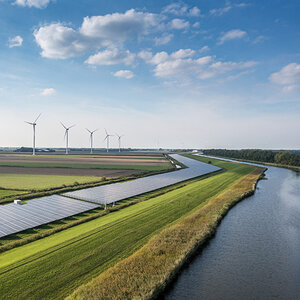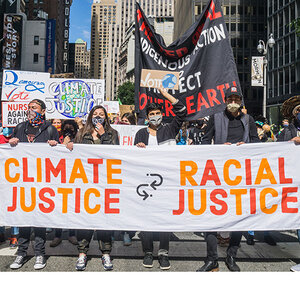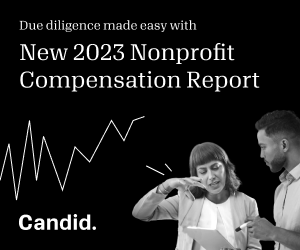The intersection of population, poverty, and climate change

In November, the United Nations will announce that the global population has surpassed eight billion people, only 11 years after we reached seven billion in 2011. The latest projections suggest that we will reach 9.7 billion in 2050 and 11.2 billion in 2100. For organizations working to reduce poverty, empower people to meet those challenges, and protect the natural world on which we all depend, the eight billion milestone is a reminder that we urgently need to understand the role of population growth in these crises, and come together to find solutions.
Population growth limits the benefits and effectiveness of the progress we make in areas such as poverty reduction, climate change mitigation, and human rights, including, for instance, from greater energy efficiency, more productive farms, or more schools and hospitals. In April 2022, for instance, the Intergovernmental Panel on Climate Change (IPCC) stated that “globally, GDP per capita and population growth remained the strongest drivers of CO2 emissions from fossil fuel combustion in the last decade.” Beyond emissions, population growth contributes to deforestation and other forms of land conversion, which limit the planet’s ability to absorb greenhouse gases.
Population growth also puts enormous strains on public services like health and education in low-income countries and on natural ecosystems services like water supplies. Stretched to capacity, it’s more difficult for communities to respond and adapt to extreme climate events like droughts or floods.
Those who currently consume the least are entitled to their greater, fairer share of the planet’s resources, and they have a fundamental right to economic security and a good quality of life. But meeting that fundamental right comes at a cost: As things stand, for everyone to use renewable resources at the same rate as in the United States, we would need five planets, which we clearly do not have. That means those who are affluent today must take less. Our future depends on living in balance with what our habitat, the Earth, can provide for all of us to live decent lives.
As our patron Sir David Attenborough has said, “All our environmental problems become easier to solve with fewer people, and harder - and ultimately impossible—to solve with ever more people.”
So why are the overall size and impact of our human numbers so rarely discussed among the solutions to these challenges? It’s partly because we are all conscious of the abuses that happened when some countries such as China forcibly limited population size. Yet few are aware of the many, many examples—from Thailand to Costa Rica to South Korea and beyond—of policies which prioritized human rights and choice while helping to slow population growth.
In Costa Rica, 60 years ago, GDP per capita stood at a mere $380, average life expectancy was 60, and the country had one of the world’s fastest population growth rates, at 3.8 percent. Today, GDP per capita has risen to over $12,000, life expectancy is around 80, and the average birth rate is under two children per family. A key factor was the country’s rights-based family planning program. Costa Rica now has one of the region’s lowest birth rates and is ranked the “happiest” country in the Global South. It was also the first tropical country to reverse deforestation—with more than half of its land now restored to rainforest.
The good news is that investment in family planning, gender equality, and girls’ education will fundamentally improve the lives of people, particularly women and girls, and help bring all the advantages of ending and reversing population growth. But that investment is not currently being made, and lives are becoming more precarious: This year, for the first time, the Human Development Index has rolled backwards for two years in a row.
We can’t get back on track unless we see the intersections between problems and solutions. We must see the holistic picture: climate change, biodiversity loss, food security, resource depletion, health, and gender equity—to name just a few—aren’t separate challenges.
As the Malala Fund has noted: “Countries that have invested in girls’ education have suffered far fewer deaths from droughts and floods than countries with lower levels of girls’ education. Additionally, if every girl was able to exercise her sexual and reproductive health and rights through quality education and had access to modern contraception, it could reduce total emissions from fossil fuels by 37%–41% by the end of the century.”
We can’t see the full picture unless we talk about the role of population, something that Population Matters has been dedicated to for more than 30 years. We understand the sensitivities and the risks, but most of all, we understand the opportunities—if the community of those who seek to do good start engaging again with this crucial, overlooked, and sometimes willfully ignored issue. We will—and do—have that conversation with people anywhere, any time.
Tackling population is not, of course, all that is required and cutting excessive consumption particularly by those of us who are rich in global terms is also critical–but no viable, ethical solution can be left out. When we address population through positive, empowering, choice-based means such as rights-based family planning, we improve lives and unleash a host of benefits that allow almost every other solution to do more good. It is an investment in our collective future that pays invaluable dividends that we cannot do without.
Robin Maynard has served as director of Population Matters since 2017. He previously held senior positions at Friends of the Earth, FARM, the Forestry Commission, the Soil Association, and latterly, at the Wildlife Trusts.







